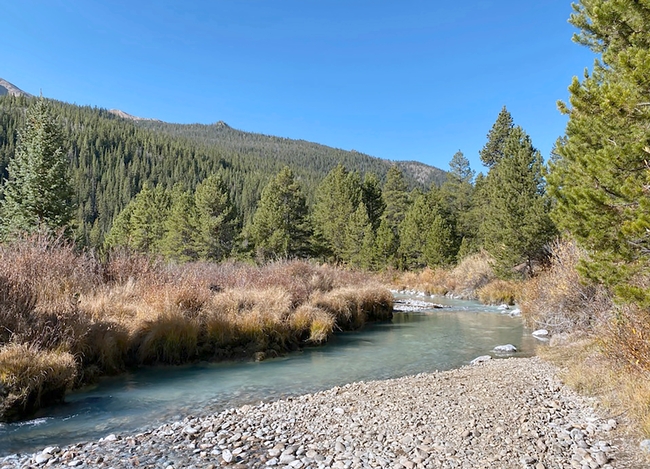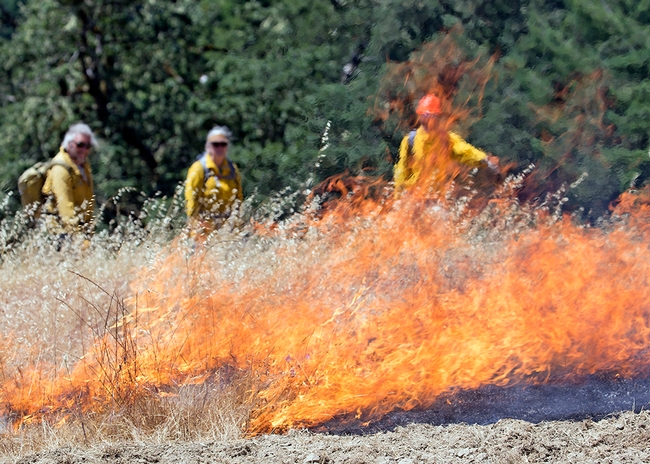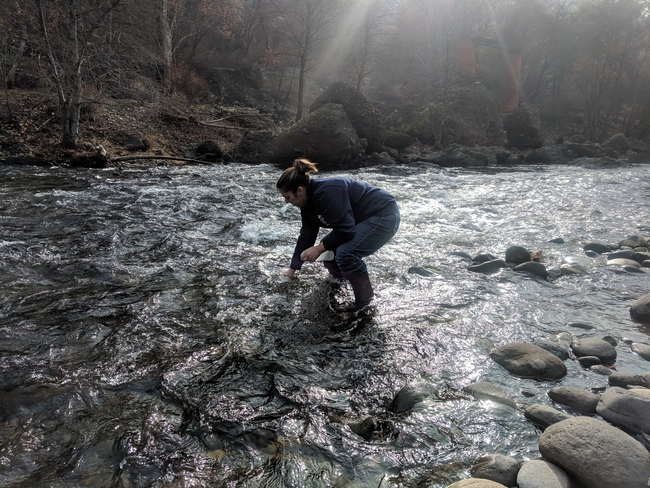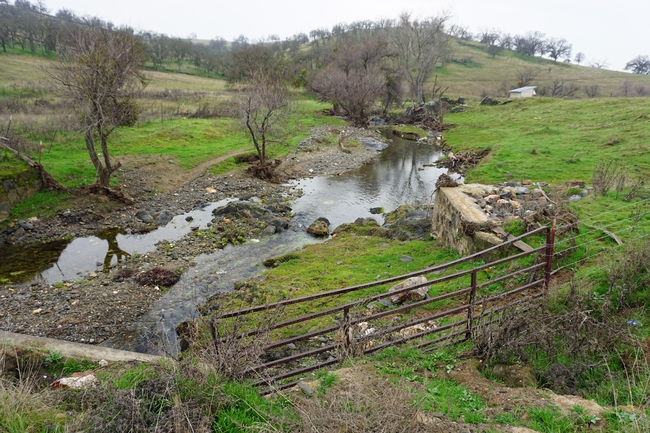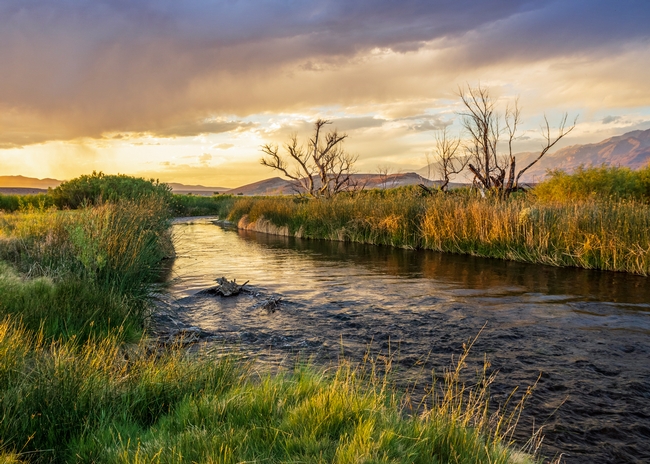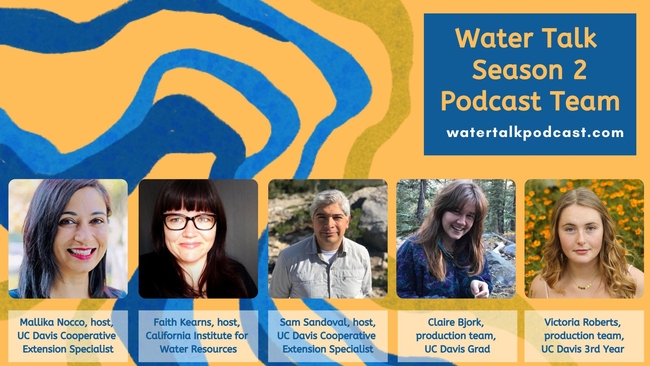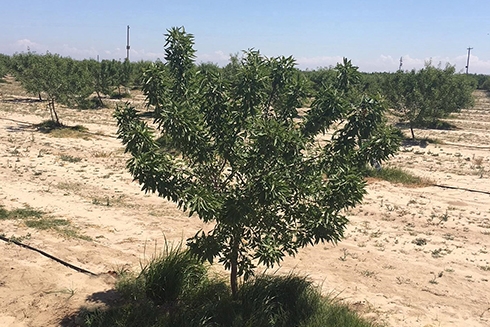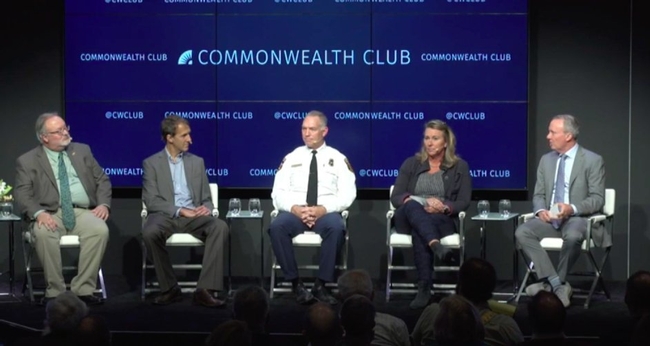Posts Tagged: Faith Kearns
How can California protect its water supply from wildfire?
Stakeholders from across disciplines and institutions offer recommendations to ensure safe, reliable water supply amid a growing wildfire threat
It's intuitive that wildfires can affect ecosystems, harm wildlife and contaminate streams and rivers. But wildfires can also have complex, severe and direct effects on our water supply and infrastructure — effects that have only become clear in recent years. Scientists and policymakers must integrate insights and experience from many disciplines and sectors to understand and address the consequences.
In September, 23 scholars and practitioners with a diversity of water and fire expertise came together to answer a critical question: How can California proactively protect its water supply from fires? Their findings, combined with the insights of the author team, form the basis of a new scoping report, released by the University of California Division of Agriculture and Natural Resources' California Institute for Water Resources and the UCLA Luskin Center for Innovation.
“Different people have different pieces of the puzzle, but it's really hard to put them together. That is why we assembled this cross-sector group,” said Faith Kearns, academic coordinator at the California Institute for Water Resources.
Illustrated by the 2017 Tubbs Fire in Wine Country, it has been recognized that community water systems face effects that last long after the fire is quenched. For example, Boulder Creek residents in Santa Cruz County still did not have reliable water access more than a year after firefighters extinguished the 2020 CZU Lightning Complex Fire.
“This is truly an emergent issue,” said co-author Peter Roquemore, project manager at the Luskin Center for Innovation. “We have only seen wildfires directly affect community water systems in the past few years.”
To help California policymakers, researchers, affected communities, and water system operators understand the complex relationship between wildfire damage and water supply, the report authors and participants in this workshop present a set of recommendations:
- Make communications more accessible, consistent and trustworthy. Residents must receive timely, unified messaging, translated into appropriate languages and in accessible venues, telling them if their water is unsafe and how to access clean water.
- Invest in local capacity and expertise. The challenges faced vary widely for different communities, and it is important to provide each community with the resources it needs to address the risk it faces. As part of this, efforts should support Indigenous leadership, knowledge and practices to help manage healthy ecosystems.
- Provide guidance to update regulations. Guidance such as building codes and infrastructure regulations will help individuals and communities make informed decisions and address risk appropriately.
- Conduct research and build a broader base of knowledge. There is still much to learn, and it is important to illustrate the exact challenges water systems face and how best to address them.
- Make funding accessible and targeted. Increased earmarked funding for emergency water supplies, housing assistance, and support for water systems, local organizations, and others will help advance solutions.
- Further coordinate efforts to address water and fire issues. Focusing on these interconnected issues together, rather than tackling them separately, can lead to substantial benefits.
To read the specific recommendations identified, read Wildfire and Water Supply in California. Funding for this research was provided by the U.S. Geological Survey through the California Institute for Water Resources.
There’s a danger in over-simplifying California water conservation
You hear it every time drought returns to California: “Turn off the faucet when you brush your teeth.” “Collect shower water in a bucket before it warms up.”
While valuable, these tried and true drought resilience strategies can also deflect attention from the monumental challenges posed by droughts to natural areas, waterways, agriculture and people in California. Far-sighted and discerning management of the state's annual precipitation and groundwater is critical, particularly as droughts become more frequent due to climate change, said Faith Kearns, the academic coordinator of UC's California Institute for Water Resources.
“Like so many big societal problems, we don't want to get caught up believing individual actions alone will solve this problem,” Kearns said. “Conserving water in households can help people feel activated and certainly conserve some water. But, at the same time, it's not enough. We have big, systemic issues to deal with.”
Urban water use in homes, landscapes, schools and businesses amounts to about 10% of total developed water use in California, according to the Northern California Water Association. Irrigated agriculture uses 41%. The remaining 51% is used for water in rivers protected by state and federal laws as “wild and scenic,” water required for maintaining habitat in streams, and water that supports wetlands in wildlife preserves.
Traditionally, when surface water supplies for California farmers are cut during droughts, farmers pumped groundwater to bridge the gap. Over time, many of the state's groundwater basins have become severely depleted. In 2014, during a devastating five-year drought, the California Legislature passed the Sustainable Groundwater Management Act to regulate groundwater use in the state for the first time. The law aims for sustainable groundwater maintenance by 2040.
“We're in the implementation phase and local groundwater agencies are in various stages of developing and implementing sustainability plans,” Kearns said. “This is an opportunity for public participation to ensure all voices are heard in the effort.”
Of particular concern are underserved rural families who rely on wells for their household water. When the water table drops due to excessive pumping, the families can be left without water for drinking, washing and bathing. Small scale farmers often meet the same fate. Larger, neighboring farms may be able to drill deeper wells.
Wintertime flooding in permeable areas is one way groundwater can be recharged as it is used during the dry season. Getting access to water, developing infrastructure and flooding large farms will allow water to seep back into aquifers. Small-scale farmers can also be involved, said Ruth Dahlquist-Willard, the UC Cooperative Extension advisor to small-scale farmers in Fresno and Tulare counties.
“If there was a way to incentivize recharge on small farms, I think we could really contribute to groundwater management,” Dahlquist-Willard said. “It is not just about how we protect small farmers but also about how we involve them and have something that works for everyone's benefit.”
Fallowing land will likely be needed to meet the groundwater law's sustainability requirements. A 2020 report by UCCE specialist David Sunding and UC Berkeley professor David Roland-Holst, Blueprint Economic Analysis: Phase One Results, estimates about 992,000 acres of California farmland will go out of production, representing $7 billion in lost crop revenue and $2 billion in lost farm operating income.
The public can support smart and equitable water management by learning about decisions being made by their own local water providers and elected government representatives that impact the future of the California water supply. UC Agriculture and Natural Resources and its California Institute of Water Resources have gathered materials to serve as a starting point for understanding and advocating for sustainable water.
Science-based drought tipsheets
Online drought and water management seminar series
Listen to these episodes of the Water Talk podcast:
Episode 02: Ranching and Water in California — Water Talk
Episode 09: Small Farms and Water in California — Water Talk
Episode 10: California Water Policy and Extension — Water Talk
Episode 15: Wild Horses and Water in California — Water Talk
Episode 16: Agriculture in the California Borderlands — Water Talk
Episode 21: Watering Urban Green Spaces — Water Talk
Find more on the UC California Institute for Water Resources website.
Drought is back! And so is Water Talk
The Water Talk podcast returns Friday, April 2, for its second season. This year's podcast will include a focus on the water issue on many minds at the end of a relatively dry rainy season: drought. As Water Talk co-host Faith Kearns says in the Season 2 preview episode, “in California, drought is not ‘if', it's ‘when'.”
The second season will include a diverse group of guests from every corner of the state; border to border. “We thought a lot about the geography of the state, the identities of the people with whom we were speaking, and the experts we were talking with, and the topics,” says co-host Mallika Nocco.
The weekly podcast will feature discussions of agriculture, water policy, environmental and social justice, land and wildlife management, water for cities, Indigenous perspectives on water, climate change, and other issues related to California water.
Some aspects of the podcast were modified in the second season as well. For example, instead of recording the podcast during a simultaneous live event, each episode was recorded with only the co-hosts. In addition, two production assistants supported the development of each episode.
“The Water Talk team has new members!” the group tweeted. “We were thrilled to welcome ultra-talented Claire Bjork and Victoria Roberts as production support for Season 2, thanks in part to a UC ANR Renewable Resources Extension Act grant.”
You can subscribe, listen and download all the episodes in Spotify, Apple and Google podcasts, as well as on the podcast's webpage. In addition to listening to the podcast, you can follow @podcast_water on Twitter for water-related news.
To catch up on Season 1 of Water Talk, visit watertalkpodcast.com.
The Water Talk podcast is hosted by Mallika Nocco, UC Cooperative Extension specialist in the UC Davis Department of Land, Air, and Water Resources; Faith Kearns, California Institute for Water Resources academic coordinator; and Samuel Sandoval Solis, UC Cooperative Extension specialist in UC Davis Department of Land, Air, and Water Resources.
February 2019 news clips
Above average rainfall in February benefits strawberry crops in the Central Valley
(ABC 30) Reuben Contreras, Feb. 28
…Above average rainfall in February will help this year's harvest last through October.
"It looks like it is in full bloom right now and it looks like it is going to rain. So we need the water as much as we can right now," said Michael Yang, University of California Cooperative Extension.
He works with small farms and specialty crops in the Hmong community, including a strawberry field in Northeast Fresno near Willow and Behymer.
Yang said the rain will add to the groundwater supply most farmers use to grow their crops plus it will help make the strawberries sweeter.
Ventura County Helps Keep Farming Alive in Southern California
(KCET) Teresa O'Connor, Feb. 27
…Connecting the community to the food system is vitally important for the health of individuals and the survival of local farms, according to Rose Hayden-Smith, Ph.D., who is the editor of the UCFoodObserver.com, an online publication for the University of California (UC). A long-term county resident, Hayden-Smith was previously sustainable food systems initiative leader for UC's Ag and Natural Resources division.
“Everyone eats: everyone is a stakeholder,” says Hayden-Smith. “I would like people to be engaged with the food system, and to advocate for positive change. Think about where your food comes from and ask critical questions about the supply chain. Meet people who are involved in producing, processing, distributing and preparing the food you eat. Honor them with questions about and interest in their work.”
Gene-edited animal creators look beyond US market
(Nature) Heidi Ledford, Feb. 20
…It isn't always easy to pick up a research project and move it to a different country. About ten years ago, difficulties finding funding for his research drove animal geneticist James Murray to move his transgenic goat project from the University of California in Davis to Brazil. The goats were engineered to produce milk that contained lysozyme, an enzyme with antibiotic properties. Murray hoped that the milk could help to protect children from diarrhoea.
https://www.nature.com/articles/d41586-019-00600-4
Newly discovered nematode threatens key crops
(Farm Press) Logan Hawkes, Feb. 20
“The arrival of this nematode (Meloidogyne floridensis) in California is a little surprising — it has the potential to infect many of California's economically important crops,” says UCCE Kern County Advisor Mohammad Yaghmour. “Root samples had been collected from an almond orchard in Merced County last year, and confirmed at the California Department of Food and Agriculture's (CDFA) Nematology Lab as M. floridensis.”
Yaghmour facilitated the second discovery of the nematode in a Kern County orchard a month after the first was uncovered in an almond orchard in Merced County.
https://www.farmprogress.com/tree-nuts/newly-discovered-nematode-threatens-key-crops
Ag Innovations Conference and Trade Show returning to Santa Maria for third event
(Santa Ynez Valley News) Mike Hodgson, Feb. 19
The Ag Innovations Conference and Trade Show will return to Santa Maria for its third event, this time focusing on biologicals, on March 5. The deadline for discounted early registration is next week.
… Considering the growing interest in biologicals and the demand for sustainably produced food, organizers selected topics on biocontrol agents, biostimulants and botanical and microbial pesticides and fungicides for the third conference, said organizer Surendra Dara, UC Cooperative Extension adviser for entomology and biologicals.
“The use of biocontrol agents, biopesticides, biostimulants and other such tools is gradually increasing in our efforts to produce with sustainable practices,” Dara said.
Almond Update: Orchard Recycling Research Showing Strong Results
(AgNet West) Taylor Hillman, Feb. 14
Orchard recycling research has been going on for over 10 years. UC Cooperative Extension Advisor Brent Holtz has been leading the project and said they continue to see positive results. There is an expense that comes with the practice but Holtz said their longest trial is making that cost back in added production.
http://agnetwest.com/almond-update-orchard-recycling-research
NASA tech helps agriculture
(Hanford Sentinel) Julissa Zavala, Feb 13,
…In keeping with the expo's theme, “Harvesting Technology,” NASA Administrator Jim Bridenstine visited the International Agri-Center in Tulare and spoke about how technology originally developed for space exploration is now being repurposed and used to improve numerous aspects of agriculture around the world.
…The measurement, also taken with LIDAR, can be used to calculate precise irrigation needs of plants and crops. Bridenstine said this pilot program, in partnership with the University of California Cooperative Extension and other agencies, is only being used in California.
UC Davis, wine industry cultivate relationship
(Fruit Growers News) Robin Derieux, Feb. 13
Under the hot summer sun of the San Joaquin Valley, just south of Merced, Miguel Guerrero of The Wine Group is trying a new high-wire act. In collaboration with University of California-Davis Cooperative Extension, Roduner Ranch vineyard manager Guerrero is experimenting with Cabernet Sauvignon vines and other varieties elevated by a single wire at 66 inches – plantings that are 2-3 feet higher than the traditional winegrape canopy.
…“The beauty of the high-wire system is that the fruit zone is really defined – a solid wall of grape clusters – and the pruning machine can just zip right alongside the vines,” said Kaan Kurtural, a UC Davis Cooperative Extension viticulture specialist. “We can carry more crop, and with mechanical leaf removal, we get that sun-dappled exposure that feeds the fruit. Less leaf cover means the vines require less water, and the grape quality is much better.”
https://fruitgrowersnews.com/article/uc-davis-wine-industry-cultivate-relationship
There's Still So Much We Need To Learn About Weed—And Fast
(Wired) Matt Simon, Feb. 11
… But late last month, UC Berkeley opened the Cannabis Research Center to start tackling some of these social and environmental unknowns. With its proximity to the legendary growing regions of Northern California, the center can start to quantify this historically secretive industry, measuring its toll on the environment and looking at how existing rules affect the growers themselves. The goal is to create a body of data to inform future policies, making cannabis safer for all.
… So for the past few years Van Butsic, codirector of the Cannabis Research Center, and his colleagues have been sifting through satellite images to pinpoint those unaccounted-for farms. “We have an army of undergraduates who look at high-resolution imagery and digitize how big the farms are, how many plants we can see,” Butsic says. Because cannabis plants love light, growers usually keep them out in the open. The researchers still miss many trespass growers, however, who tend to hide their plants in the brush to avoid detection.
https://www.wired.com/story/theres-still-so-much-we-need-to-learn-about-weed
Cultured meat: Good or bad, promise or peril?
(Agweek) By Jonathan Knutson, Feb. 11
…To Alison Van Eenennaam, University of California-Davis Extension specialist in animal biotechnology and genomics, proponents of cell-based meat are "overhyping the environmental benefits" and providing an incomplete, misleading case for it.
https://www.agweek.com/business/agriculture/4568613-cultured-meat-good-or-bad-promise-or-peril
Broomrape Weed Spreads Quickly
(AgNet West) Taylor Hillman, Feb. 8
By the time you see broomrape weed in your fields, it may be too late. There has been a resurgence of broomrape reports over the last decade in California. Retired UC Cooperative Extension Farm Advisor Gene Miyao said although the parasitic weed is far from widespread, it could become so quickly. “The seeds are very small, the growth is primarily underground until it starts sending up shoots and then it very quickly starts setting seed,” he said. “A single seed attached to a tomato plant may send up half-a-dozen shoots, and each shoot might have 1,000 seeds or more.”
http://agnetwest.com/broomrape-weed-spreads-quickly/
New CA Bill Aims to Help Prepare Farmers for Extreme Weather, Changing Climate
(YubaNet) CalCAN, Feb. 7
The state and University of California have made significant investments in research to better understand agriculture's unique vulnerabilities and adaptation strategies to a changing climate, including in the state's recently released Fourth Climate Change Assessment. But not enough has been done to translate climate risks to the farm level and assist farmers in adapting to climate change.
…The bill would also fund trainings for technical assistance providers and agricultural organizations. According to a 2017 survey of 144 University of California Agriculture and Natural Resources staff, 88% of respondents believe it is important to incorporate climate change information into farm extension programs, but only 43% actually do. Respondents cited a lack of access to climate information relevant to farmers and expressed interest in education on technical tools and information resources.
Top administrators from UC ANR visit Imperial Valley
Imperial Valley Press
They were also briefed about UCCE and DREC projects, accomplishments and barriers by the directors, county advisors and CES representatives.
Drought concerns loom for California farmers, ranchers despite recent rain
(KSBY) Dustin Klemann, Feb. 6
Even with the onslaught of rainy weather, the U.S. Drought Monitor states San Luis Obispo County and Santa Barbara County remain in a moderate drought.
On Wednesday, the UC Cooperative Extension held a workshop in Solvang titled “Weather, Grass, and Drought: Planning for Uncertainty.”
“Leave it to a drought workshop to bring the rain,” Matthew Shapero joked. He is a livestock and range advisor for UCCE.
Shapero pointed out a call he received questioning the monitor's accuracy on a local level.
“He said ‘I really don't think the drought monitor accurately reflects what I am seeing on the ground.'”
… “We Californians are constantly accused of not having seasons. We do,” said Dr. Royce Larsen, an advisor of the UCCE. “We have fire, flood, mud, and drought. That's what we live with. And it's getting more and more so every year.”
California legislators honor Summit's Steward Leader Award Winners
(California Economic Summit, Feb. 5
Monday, February 4 was a red-letter day for stewardship in California. Not only was the California Legislature celebrating the Chinese Lunar New Year and “National Wear Red Day” as a symbol of support for women's heart health, but members of both houses also paused to recognize Glenda Humiston and Paul Granillo as recipients of the California Economic Summit's 2018 Steward Leader Awards.
Revealed: how big dairy pushed fattier milks into US schools
(Guardian) Jessica Glenza, Feb. 4
…A nutritionist for the University of California called the idea that chocolate milk could help athletes “preposterous”.
“Milk is a very healthy beverage, it's got protein, calcium, vitamin D – there's a reason we are mammals and grow up drinking milk,” said Lorrene Ritchie, the director of the Nutrition Policy Institute at the University of California. “There's nothing about adding chocolate to it that's going to help an athlete.”
https://www.theguardian.com/us-news/2019/feb/03/revealed-dairy-lobby-fat-milk-trump-sonny-perdue
California's water paradox
(Morning Ag Clips/The Conversation) Faith Kearns and Doug Parker, Feb. 4
These days, it seems everyone is looking for a silver bullet solution to California's drought. Some advocate increasing supply through more storage, desalination or water reuse. Others propose controlling demand through conservation or restriction of water use by urban and agricultural users.
https://www.morningagclips.com/californias-water-paradox
Camp Fire: When survival means shelter
(Mercury News) Lisa Krieger, Feb. 2
“We have to talk about it, as a community, to reduce vulnerability – especially for citizens who don't drive,” said Scott Stephens, co-director of UC-Berkeley's Center for Fire Research and Outreach. “In the Camp Fire, people didn't die because they wanted to stay. They had to stay. All of a sudden, the fire was at their front door step.”
For Australia's policy to work in California, residents must be physically and mental trained, said wildfire specialist Max A. Moritz with UC's Division of Agriculture & Natural Resources. In Australia, which conducts formal training, “there is active participation from homeowners … so both homes and people are better prepared.”
https://www.mercurynews.com/2019/02/02/wildfires-when-survival-means-shelter/
December news clips
Franz Niederholzer - 2019 New Year's Profile
(Appeal-Democrat), Dec 31
Keeping Up with Navel Infections
(Dairy Herd Management) Emre Gürdal and Noelia Silva del Rio, Dec. 31
How Do Wildfires Start?
(Live Science) Donavyn Coffey, Dec. 28
…In other words, "a source [of heat] hits receptive fuel that's dry enough to burn," said Lenya Quinn-Davidson, a fire analyst for the University of California Cooperative Extension forestry program in Northern California. In the right conditions, those three factors are all it takes to set a wildfire in motion.
…However, ignition is only the beginning. For a spark to grow into a sustained wildfire, there must be a perfect combination of factors, such as "dry conditions and really strong winds," Quinn-Davidson told Live Science. And because of climate change, dry conditions are lasting longer and, in turn, causing longer fire seasons.
https://www.livescience.com/64378-how-do-wildfires-start.html
Analyzing The Use of Selective Dry Cow Therapy
(Dairy Herd Management) Fernanda C. Ferreira and Emmanuel Okello, Dec 27
Private woodlands lost to California wildfire — and may not be replaced
(SF Chronicle) Peter Fimrite Dec. 25,
…It costs about $400 per acre to reforest land, said Bill Stewart, a forestry specialist at UC Berkeley who has studied forest restoration programs after fires.
“A lot of (small property owners) ... don't have the cash or professionals to do the job,” he said. They “take a big financial hit when their forests are caught in a wildfire.”
…Max Moritz, a wildfire specialist at the University of California Cooperative Extension, said wholesale clearing is not always necessary. The rush to clear the land, he said, can result in healthy trees being cut down.
“Many trees can survive pretty bad crown scorch, so there's generally no urgency to get them out, or there shouldn't be, anyway,” said Moritz, an adjunct professor at UC Santa Barbara. “This is especially true of species that resprout, like several of the oaks and also redwoods.”
Get to know your wasps: University of California entomologist addresses misconceptions
(Press Democrat) Kate Frey, Dec. 21
Rachael Long, a University of California Cooperative Extension entomologist and crop adviser, recently told me a story about three wasps that people frequently encounter around their homes and often have misconceptions about.
https://www.pressdemocrat.com/lifestyle/9077426-181/get-to-know-your-wasps
Gene Editing Finds its Way to the Farm
(Dairy Herd Management) Clinton Griffiths, Dec. 21
…Alison Van Eenennaam, animal geneticist, University of California-Davis, says edits that create polled herds will soon be common.
“It's kind of like a pair of molecular scissors, if you will, that you can tell to go and cut the DNA at a very precise location in the genome,” Van Eenennaam explains. “What that enables you to do is go in and very precisely alter one particular gene of the thousands of genes that make up the genome, and you can introduce useful genetic variations.”
https://www.dairyherd.com/article/gene-editing-finds-its-way-farm
Farm Bill Set to Bring Several Benefits to California Growers
(AgNet West) Brian German, Dec. 19
...“There's some really good stuff in it for California, I mean first of all, getting a farm bill is fantastic,” said Vice President of UC Agriculture and Natural Resources Glenda Humiston. “Some really good things for beginning farmers and ranchers, and veterans' efforts in ag. One thing that's really potentially exciting for California in the rural development title is increasing the eligibility of communities up to 50,000 for some of the programs.”
http://agnetwest.com/farm-bill-benefits-california-growers
Gene-edited farm animals are coming. Will we eat them?
(Washington Post) Carolyn Y. Johnson, Dec. 17
...“Right now. This is exciting, right this minute,” animal geneticist Alison Van Eenennaam said as she waited for a tiny blob of a fetus to materialize on a laptop screen on a recent afternoon at the Beef Barn, part of the University of California at Davis's sprawling agricultural facilities for teaching and research.
Commentary: Is Atascadero prepared?
(Atascadero News) Ray Weymann, Dec. 14
…But often, even 10 feet from a house takes one into a neighbor's property. Whether this means mandating more aggressive tree and brush clearing, and reevaluation of building codes for new and existing structures, is something the new council should consider, availing themselves with input from our local fire department but also from people like Jack Cohen. Another wildfire expert, Max Moritz, suggests that governments must be more aggressive in not allowing development in areas especially vulnerable to wildfire.
https://atascaderonews.com/article/commentary-is-atascadero-prepared
Ceres Imaging unveils cumulative stress index
(Successful Farming) Laurie Bedord, Dec. 14
...“Findings over the last four years show that the average Ceres Imaging conductance measurement from its imagery over the season has provided the best correlation with applied water,” says Blake Sanden, a Kern County University of California Cooperative Extension farm adviser. “While there's no perfect predictor of final yield, Ceres Imaging aerial sensing of canopy plant stress has a significant relationship with final yield.”
https://www.agriculture.com/news/technology/ceres-imaging-unveils-cumulative-stress-index
New Farm Bill Provides Funds For Research In California ‘Ag,' But No Big Boons
(Capital Public Radio) Julia Mitric, Dec. 13
…"What's fascinating about the Farm Bill is, after all that hyper-partisan debate … it's really a lot of the same of what we already had," said Glenda Humiston, vice president of University of California Agriculture and Natural Resources.
Humiston is pleased that California will get an increase of $25 million a year for research of specialty crops, agricultural jargon for fruits, vegetables and nuts, as opposed to commodity crops like soybeans, corn and wheat. Those federal grants will cover many areas, from adapting farming to the effects of climate change to finding cures for California's many invasive pests, Humiston said.
Can California Improve Forest Management And Prevent Wildfires Without Going Broke?
(Capital Public Radio) Ezra Romero, Dec. 13
...But can California expand programs like forest-thinning and controlled burns and manage its forests on the cheap?
UC Berkeley forestry specialist Bill Stewart says yes. “There's certain areas that it is going to cost you $700 an acre, but other acres you can treat for $50 or $100 an acre,” Stewart said.
Technology advances impact production efficiency
(AgriNews) Martha Blum, Dec. 13
“I'm passionate about genetics and sticking up for technology because if we don't stand up for it, we're not going to have access to it,” said Alison Van Eenennaam, Cooperative Extension specialist in the Department of Animal Science at University of California, Davis.
“The livestock industry doesn't have access to GMOs because of the debate around plant GMOs,” Van Eenennaam said during a presentation at the 2018 American Agri-Women Convention.
Lindcove squeezes 100 citrus varieties into one tasting
(Sun Gazette) Dec. 12
The University of California citrus research center swings open its doors this week to give farmers and the public the opportunity to view and taste more than 100 varieties of citrus.
Can Rakes Save Forests? Yes, As Long As You Have A Drip Torch In The Other Hand, UC ANR Says
(Sierra Sun-Times) Susie Kocher, Rob York, and Lenya Quinn-Davidson, Dec. 12
Have shears, will travel
(California Bountiful) Ching Lee
…Sheep owners, particularly those with small flocks, have had trouble finding shearers for years—and the smaller their flock, the harder it is to get someone to shear for them because shearers are paid by the number of animals they shear, said John Harper, a UC livestock and natural resources advisor who has run the annual shearing program for nearly 25 years.
http://www.californiabountiful.com/features/article.aspx?arID=2199
Could legalizing cannabis help the environment?
(Physics World) Kate Ravilious, Dec. 11
Using high resolution satellite imagery for the years 2012 and 2016, Van Butsic from the University of California, Berkeley and his colleagues found a boom in cultivation of cannabis in Mendocino and Humboldt Counties. By zooming right in, the researchers could identify the distinctive shape of the cannabis plants, the regular pattern in which the crop is planted, and the greenhouses perched in unusual places.
...“The chances of environmental damage are much greater in these regions because of the high potential for erosion, which threatens water quality, high potential for using water directly from headwaters, and the need to build roads to access these farms,” says Butsic.
https://physicsworld.com/a/could-legalizing-cannabis-help-the-environment/
What Does It Take To Defend Your Home Against A Mega Wildfire Like The Camp Fire? Here's How One Couple Survived
(Capital Public Radio) Ezra David Romero, Dec. 11
...Earlier this year, University of California system forest advisor Yana Valachovic toured the Carr Fire burn area in Redding.
“What surprised me there was how many of the stucco homes were lost and they were surrounded by green lawn,” Valachovic recalled. “What the mechanism of entry was is that they had a ring of vegetation right around the outside of their house.”
Susie Kocher, a forest adviser for the Lake Tahoe region with the UC Cooperative Extension, often works with homeowners that live within the Angora Fire burn area. That blaze destroyed about 250 homes in Lake Tahoe in 2008. A decade later, Kocher said people still aren't properly preparing their homes.
“There's still a lot of flammable plants planted right under picture windows,” Kocher said, adding that people have almost set themselves up for failure, “perhaps in the mistaken belief that they are kind of safe now because there's no big trees.”
https://www.kpbs.org/news/2018/dec/11/what-does-it-take-defend-your-home-against-mega-wi
Wildfire scientists brace for hotter, more flammable future as Paradise lies in ashes
(CNN) Bill Weir, Dec. 10
…"Well, my colleague Katharine Hayhoe says climate change is like gravity," says Dr. Faith Kearns. "Climate change doesn't really care if you believe in it or not. It's reality. We have gravity, we have climate change."
https://www.cnn.com/2018/12/10/us/california-wildfires-climate-weir-wxc/index.html
Are Your Bananas at Risk?
(BYU Radio) Top of Mind, Dec. 10
Guest: Norman C. Ellstrand, Distinguished Professor of Genetics, Department of Botany and Plant Sciences, University of California, Riverside
...Here in the US, there's only one kind of banana in the supermarket – sweet, yellow, no seeds, about as long as your hand. It's a variety called Cavendish and it dominates the international banana market. Which turns out to be a big problem.
Jeff Mitchell: Conservation No-Till Is One Option For Water Conservation
(Cal Ag Today) Patrick Cavanaugh, Dec. 10
Jeff Mitchell is a Cropping Systems Specialist at UC Davis, based at the Kearney Agricultural Research and Extension Center in Parlier. He has devoted his 19 years to improving nitrogen and water use efficiencies in food, feed, fuel and fiber in no-till cropping systems.
https://californiaagtoday.com/jeff-mitchell-conservation-no-till-one-option-water-conservation/
Solano 4-H schedules Fairfield open house
(Fairfield Daily Republic) Susan Hiland, Dec. 9
The Solano County 4-H Youth Development Program will host a 4-H open house from 5:30 to 8:30 p.m. Wednesday on the first floor of the University of California Cooperative Extension Office, 501 Texas St.
California State Fair Extra Virgin Olive Oil Competition opens Jan. 8
(Lake Co News) Dec. 8
…The California State Fair is proud to announce the head judge for the 2019 competition, Mr. Paul Vossen. Vossen will employ his expertise and experience at the California State Fair olive oil judging to lead the team of 15 Judges and ensure a fair and ethical judging process.
With more than 30 years of experience in the field as a University of California Cooperative Extension Farm Advisor in Sonoma County, Paul Vossen offers practical advice to large commercial ventures and hobby farmers alike for clients around the world.
Getting the Facts Straight on Dairies
(California Dairy) Dec. 7
The inaugural California Dairy Sustainability Summit in Sacramento last month was a big hit. Conference presentations not only focused on what California dairy producers can do to increase their sustainability efforts, but also on how producers can better share their stories and correct some of the common misconceptions that have been circulating the public. Check out this video with Frank Mitloehner, Air Quality Specialist from the Department of Animal Science at UC Davis, who shared the facts, and read more about it in California Dairy Magazine.
http://www.californiadairymagazine.com/2018/12/07/getting-the-facts-straight-on-dairies
Why Californians Were Drawn Toward the Fire Zones
(Wall St Journal) Jeffrey Ball, Dec. 7
…Lax building codes are at the base of the problem. Even in California, which has some of the toughest such rules in the country, they often aren't adequate or adequately enforced. The codes often dictate the use of fire-retardant materials in house construction but typically say nothing about how a development must be situated on the landscape—and that can help determine whether that development will burn in a fire, says Max Moritz, a cooperative-extension wildfire specialist at the University of California, Santa Barbara. “So the developers are able to come in, propose something, and often, without too much oversight, walk away after having built something in a dangerous place,” he says. “And we pick up the tab.”
https://www.wsj.com/articles/why-californians-were-drawn-toward-the-fire-zones-1544202053?mod=e2tw
Cutting down Christmas trees on public land is good for forest management: expert
(KTVU) Lisa Fernandez, Dec. 7
A forestry advisor for the University of California is a big proponent of cutting down Christmas trees on public land as an inexpensive, family-friendly holiday ritual and a way to thin the forests of excessive small trees.
Susie Kocher, who works for the UC Cooperative Extension, has been trekking to the U.S. Forest Service land for the last two decades -- saw and $10 permit in hand -- to cut down her own white fir.
Researchers study how to enrich soil
(Appeal-Democrat) Ruby Larson, Dec. 6
Soil health and research on using cover crops were discussed by farmers, researchers and others at the University of California Cooperative Extension's Soil Health and Cover Crop Field Day on Thursday morning.
Dozens gathered for a presentation on the Healthy Soils Project, which the local UCCE is participating in. The project focuses on managing soil health, changes in soil carbon and reducing greenhouse gases.
…Amber Vinchesi and Sarah Light, agronomy adviser for UCCE Sutter-Yuba, gave a demonstration on how they would test for greenhouse gasses during the course of the project.
Climate Extremes: the New Norm
(Santa Barbara Independent) Laura Capps, Dec. 6
...“We need to change our perspective to one of co-existing with fire instead of fighting it,” said Dr. Max Moritz, a University of California wildfire scientist. “Fire isn't going away anytime soon. We need to locate and build our communities accordingly so that we reduce our vulnerability over the long term to this essential and inevitable natural process that is wildfire.”
https://www.independent.com/news/2018/dec/06/climate-extremes-new-norm
Will More Permits To Chop Down Christmas Trees Help Thin California Forests And Prevent Wildfires? (AUDIO)
(Capital Public Radio) Ezra David Romero, Dec 5
In a patch of forest a few miles from Lake Tahoe's shore, Susie Kocher and her family are crunching through the snow to find a Christmas tree.
…"It's a great win-win solution,” said Kocher, who is also a forest advisor for the University of California Cooperative Extension for the Lake Tahoe area. “You get the public out in the forest, you do good work reducing the density of the trees."
Wildland fire research and impacts on nut orchards
(Western Farm Press) Logan Hawkes, Dec 5
..So far, tree nut damages or other agricultural losses in the deadly Camp Fire are unknown according to UCANR Sustainable Orchard Farm Advisor Luke Milliron in Butte County.
https://www.farmprogress.com/tree-nuts/wildland-fire-research-and-impacts-nut-orchards
Fruit tree owners get free lesson in pruning
(The Californian) John Karlik, Dec 5
Even those with the greenest thumbs may need some guidance when it comes to pruning trees. The University of California Cooperative Extension office is here to help again with its annual fruit tree pruning demonstrations on Dec. 12 and 13.
Starting at noon both days in the orchard of the cooperative's office, ag adviser Mohammad Yaghmour will show attendees how to trim back trees including apple, apricot, cherry and almond as well as grapevines.
Camp Fire Impacted Local Prescribed Fire Training
(My Mother Lode) Tracey Petersen, Dec 5
...The 20 participants were to get hands-on fire experience to better understand the art and science of fire management and ecology. However, organizer and Natural Resources Advisor at the University of California Cooperative Extension – Central Sierra Susan Kocher relays that due to the explosion of the Camp Fire no flames could be ignited for the training because the required back up resources were called to battle the mega blaze. She adds it is an ongoing problem regarding using prescribed burns for fire prevention. “I really think it shows just our exact dilemma. It's hard to get ahead of disasters because you're busy responding to disasters,” advised Kocher. “So, we just need to do everything we can to try and burn at all times of year to try to get ahead of these tragic wildfires that are happening.”
The New Abnormal: A Town Hall on California's Fires and the Future
(Commonwealth Club) Dec. 4, 2018
… To address some of these critical and urgent questions, please join The Commonwealth Club for a special free town hall on California's fires and what can be done in the short and long term to prepare for them.
Guests:
J. Keith Gilless, Chair, California Board of Forestry and Fire Protection; Professor of Forest Economics, UC Berkeley
Thom Porter, Chief of Strategic Planning, California Department of Forestry and Fire Protection (CAL FIRE)
Kurtis Alexander, Water, Wildfire and Climate Writer, San Francisco Chronicle
Maggi Kelly, Professor and Cooperative Extension Specialist in the Environmental Science, Policy and Management
Valley's Gold: Food Safety
(Valley's Gold) Dec. 4
Learn about the economic engine that drives the region, Agriculture. With host Ryan Jacobsen
UC CalFresh Nutrition Education Specialist Elizabeth Lopez shares food safety tips and tools in this PBS episode starting at the 18:32 mark.
https://www.pbs.org/video/valleys-gold-food-safety-bqfgv4
San Diego County wants to build 10,000 new homes in fire-prone areas
(San Diego Union Tribune) Joshua Emerson Smith, Dec. 3
…What these building codes and other rules don't take into account is whether a particular project should be built at all, said Max Moritz, a cooperative extension specialist in wildfire at the Bren School at UC Santa Barbara.
“There's all these hazards that we use to guide our building and our zoning from floods to landslides, and fire is not one of them,” Moritz said.
“In the end, the taxpayer is left holding the bill for all this,” he added. “The developer may do a really good job at designing and convincing everybody that it's the right thing to do, but after they walk away, the public is left doing fuels maintenance for decades, and the public picks up the bill when there's a disaster.”
California is managing its forests — but is the president managing its federal lands?
(NBC News) James Rainey, Dec. 2
...Scott Stephens, a University of California, Berkeley professor of fire science, said the fire cataclysms of the last two years seem to have ended a long era of inattention.
“We will start to change the trajectory,” he said, “so we won't have tragedies like we had in Paradise.”
Subfreezing temperatures predicted for early Monday in Modesto area
(Modesto Bee) Deke Farrow, Dec. 2
...The University of California Cooperative Extension in Sacramento County offers more


